Policy, Technology, and Management Options for Water Conservation in the Ogallala Aquifer in Kansas, USA
Abstract
:1. Introduction
2. Kansas Irrigated Agriculture Background
2.1. Water Policy
2.2. Irrigated Agriculture in Kansas
2.3. Resource Monitoring
3. Innovation to Enhance Sustainability of the Ogalalla Aquifer
3.1. Innovations in Policy
3.2. Innovations in Technology
3.3. Innovations in Management
4. Demonstrated Water Conservation
4.1. Farm and Field Scale Conservation
4.2. Collective Action for Conservation
4.3. Impacts of Conservation on Groundwater Depletion
5. Applicability to Other States and Regions
Author Contributions
Funding
Data Availability Statement
Acknowledgments
Conflicts of Interest
Abbreviations
| GMD | Groundwater Management District |
| IGUCA | Intensive Groundwater Use Control Area |
| KSRE | Kansas State Research and Extension |
| LEMA | Local Enhanced Management Area |
| LEPA | Low-Energy Precision Application |
| LESA | Low Elevation Spray Application |
| MDI | Mobile Drip Irrigation |
| SDI | Sub-Surface Drip Irrigation |
| WCA | Water Conservation Area |
| WRIS | Water Rights Information System |
Appendix A

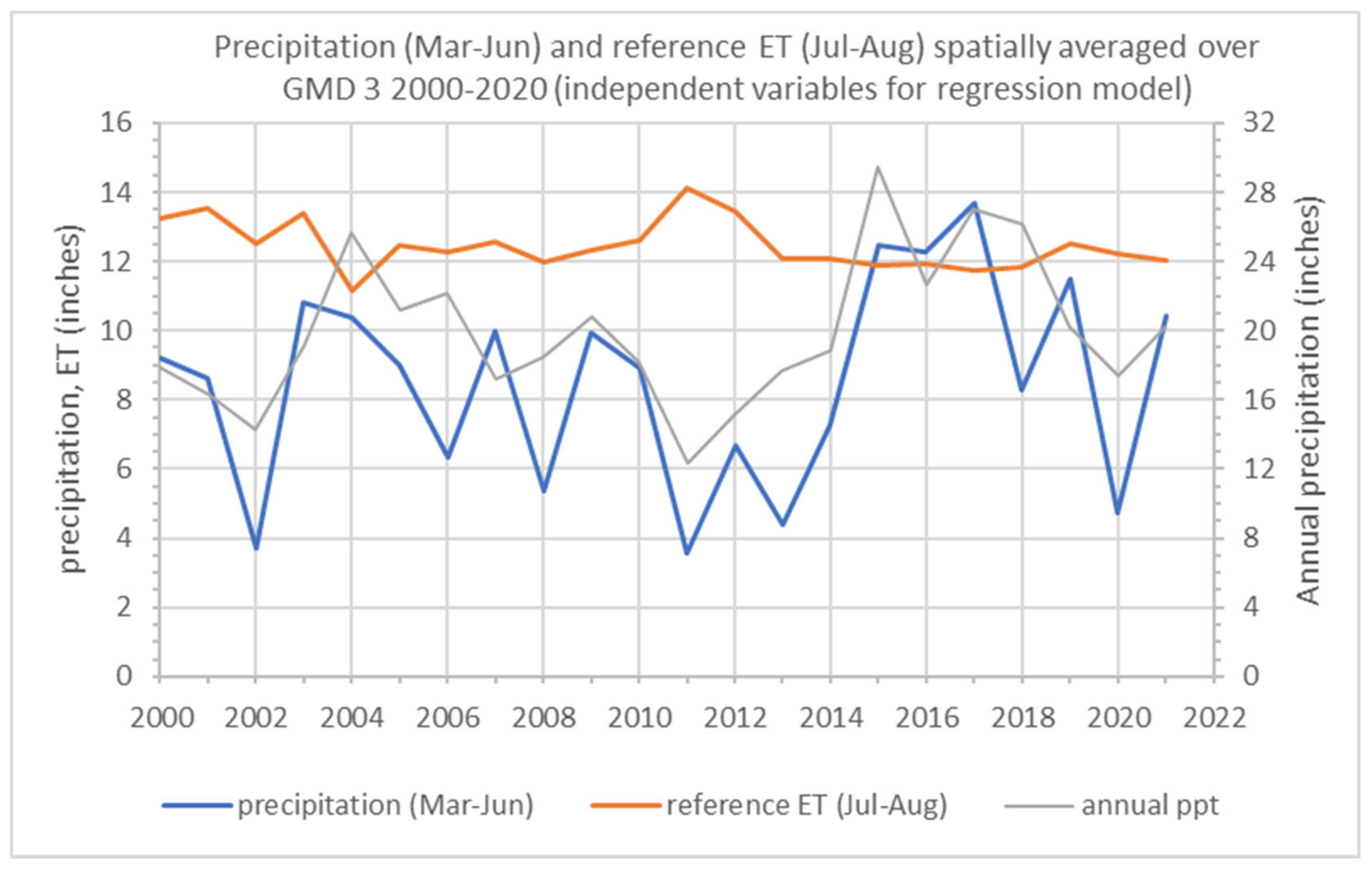
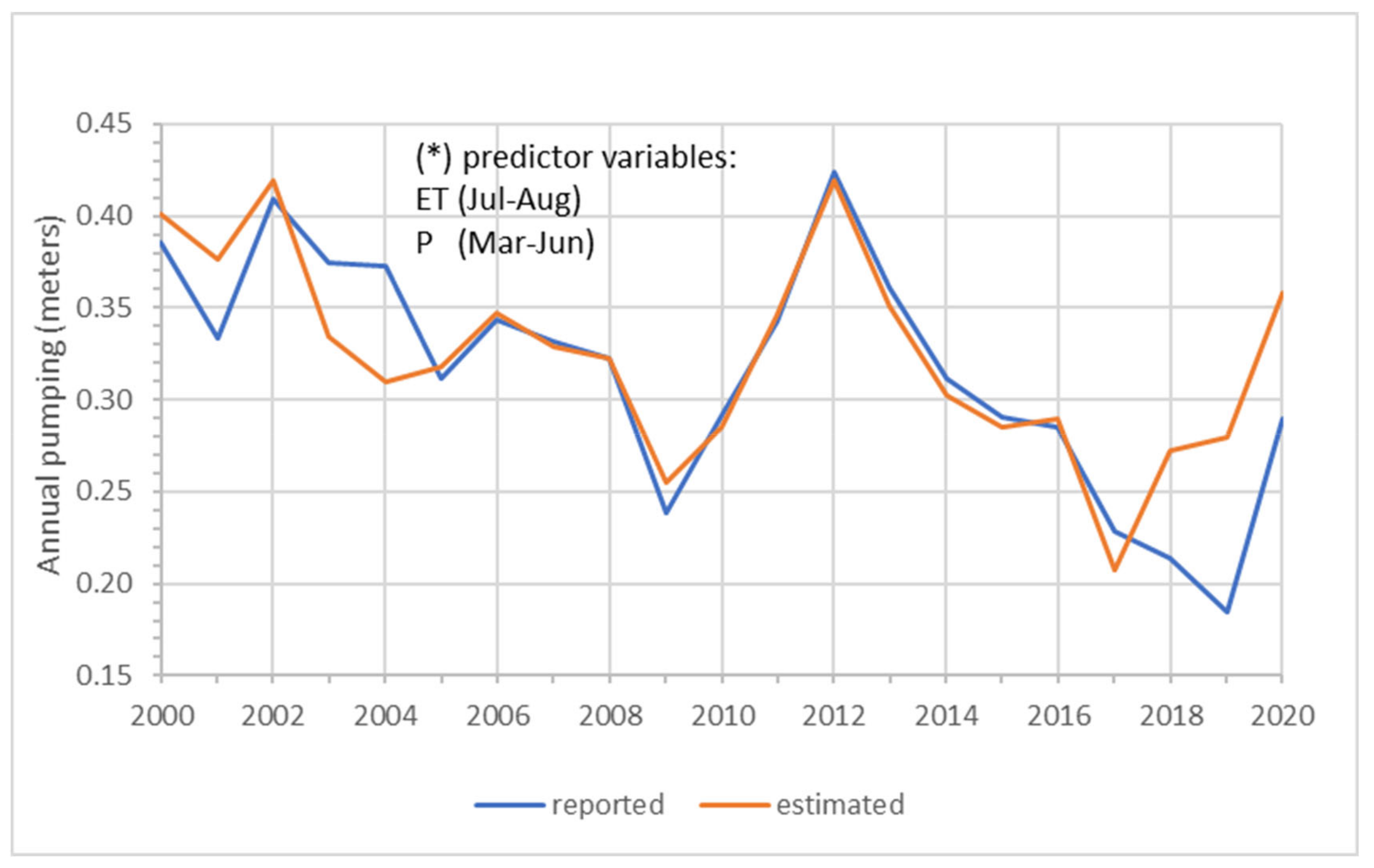

References
- Gowda, P.; Steiner, J.L.; Olson, C.; Boggess, M.; Farrigan, T.; Grusak, M.A. Agriculture and Rural Communities. In Impacts, Risks, and Adaptation in the United States: Fourth National Climate Assessment, Volume II; Reidmiller, D.R., Avery, C.W., Easterling, D.R., Kunkel, K.E., Lewis, K.L.M., Maycock, T.K., Stewart, B.C., Eds.; U.S. Global Change Research Program: Washington, DC, USA, 2018; pp. 391–437. [Google Scholar] [CrossRef]
- IPCC. 2021: Summary for Policymakers. 2021. In Climate Change 2021: The Physical Science Basis. Contribution of Working Group I to the Sixth Assessment Report of the Intergovernmental Panel on Climate Change; Masson-Delmotte, V., Zhai, P., Pirani, A., Connors, S.L., Péan, C., Berger, S., Caud, N., Chen, Y., Goldfarb, L., Gomis, M.I., et al., Eds.; Cambridge University Press: Cambridge, UK, in press; Printed October 2021 by the IPCC, Switzerland.
- Kukal, M.S.; Irmak, S. Impact of irrigation on interannual variability in United States agricultural productivity. Agric. Water Manag. 2020, 234, 106141. [Google Scholar] [CrossRef]
- Rehkamp, S.; Canning, P.; Birney, C. Tracking the U.S. Domestic Food Supply Chain’s Freshwater Use over Time; U.S. Department of Agriculture, Economic Research Service: Washington, DC, USA, 2021; ERR-288.
- Gleick, P.H.; Pacific Institute; Ajami, N.; Christian-Smith, J.; Cooley, H.; Donnelly, K.; Fulton, J.; Ha, M.-L.; Heberger, M.; Moore, E.; et al. The World’s Water: The Biennial Report on Freshwater Resources Volume 8; Island Press: Washington, DC, USA, 2014. [Google Scholar]
- Dieter, C.A.; Maupin, M.A.; Caldwell, R.R.; Harris MAIvahnenko, T.I.; Lovelace, J.K.; Barber, N.L.; Linsey, K.S. Estimated Use of Water in the United States in 2015; U S Geological Survey Circular 1441, U.S. Department of the Interior, U.S. Geological Survey: Reston, VA, USA, 2018. [Google Scholar]
- Famiglietti, J.S.; Ferguson, G. The hidden crisis beneath our feet: Disappearing groundwater requires widespread action to prevent widespread water scarcity. Science 2021, 372, 344–345. [Google Scholar] [CrossRef]
- Qi, S.L. Digital Map of Aquifer Boundary for the High Plains Aquifer in Parts of Colorado, Kansas, Nebraska, New Mexico, Oklahoma, South Dakota, Texas, and Wyoming: U.S. Geological Survey Data Series 543. 2010. Available online: http://pubs.usgs.gov/ds/543/ (accessed on 29 November 2021).
- Gowda, P.; Bailey, R.; Kisekka, I.; Lin, X.; Uddameri, V. Featured series introduction: Optimizing Ogallala Aquifer water use to sustain food systems. JAQWA 2019, 55, 3–5. [Google Scholar] [CrossRef] [Green Version]
- McGuire, V.L. Water-Level and Recoverable Water in Storage Changes, High Plains Aquifer, Predevelopment to 2015 and 2013–15; U.S. Geological Survey Scientific Investigations Report 2017–5040, U.S. Geological Survey: Reston, VA, USA, 2017; 14p. [Google Scholar] [CrossRef]
- Steiner, J.L.; Briske, D.D.; Brown, D.P.; Rottler, C.M. Vulnerability of Southern Plains agriculture to climate change. Clim. Chang. 2018, 146, 201–218. [Google Scholar] [CrossRef] [Green Version]
- Deines, J.M.; Kendall, A.D.; Crowley, M.A.; Rapp, J.; Cardille, J.A.; Hyndman, D.W. Mapping three decades of annual irrigation across the US High Plains Aquifer using Landsat and Google Earth Engine. Rem. Sen. Environ. 2019, 233, 111400. [Google Scholar] [CrossRef]
- Bailey, R.T.; Schipanski, M.E.; Kisekka, I. Special issue introduction: Managing the Ogallala. Agric. Water Manag. 2020, 233, 106405. [Google Scholar] [CrossRef]
- Evett, S.R.; Colaizzi, P.D.; Lamm, F.R.; O’Shaughnessy, S.A.; Heeren, D.M.; Trout, T.J.; Kranz, W.L.; Lin, X. Past, present and future of irrigation on the U.S. Great Plains. Trans. ASABE 2020, 63, 703–729. [Google Scholar] [CrossRef]
- Musgrove, M. Groundwater Quality in the High Plains Aquifer: U.S. Geological Survey Fact Sheet 2019-3055; Kansas Geological Survay: Lawrence, KS, USA, 2020; 4p. [Google Scholar] [CrossRef] [Green Version]
- Lauer, S.; Sanderson, M.R.; Manning, D.T.; Suter, J.F.; Hrozencik, R.A.; Guerrero, B.; Golden, B. Values and groundwater management in the Ogallala Aquifer region. J. Soil Water Conserv. 2018, 3, 593–600. [Google Scholar] [CrossRef]
- Guerrero, B.B.; Golden, K.; Schoengold, J.; Suter, A.; Stoeker, C.; Goemans, D. Manning. Groundwater laws across the Ogallala Aquifer region. Colo. Water 2017, 34, 12–16. [Google Scholar]
- Rogers, D.H.; Powell, G.M.; Ebert, K. Water Primer, Part 5: Water Law; Kansas State University: Manhattan, KS, USA, 2013; MF-3024. [Google Scholar]
- Kansas Department of Agriculture (KDA). Irrigation Water Use in Kansas, 2017. KDA Division of Water Resources in Cooperation with the United States Geological Survey. 2017. Available online: https://agriculture.ks.gov/divisions-programs/dwr/water-appropriation/water-use-reporting (accessed on 27 September 2021).
- Whittemore, D.O.; Butler, J.J., Jr.; Wilson, B.B. Status of the High Plains Aquifer in Kansas. In Kansas Geological Survey 2018; Technical Series 22; Kansas Geological Survey: Lawrence, KS, USA, 2018; Available online: http://www.kgs.ku.edu/Publications/Bulletins/TS22/index.html (accessed on 10 September 2021).
- Rogers, D.H.; Lamm, F.R. Kansas Irrigation Trends. In Proceedings of the 24th Annual Central Plains Irrigation Conference, Colby, KS, USA, 21–22 February 2012; Thompson: Colby, KS, USA, 2012. [Google Scholar]
- Luckey, R.R.; Gutentag, E.D.; Weeks, J.B. Water-Level and Saturated-Thickness Changes, Predevelopment to 1980, in the High Plains Aquifer in Parts of Colorado, Kansas, Nebraska, New Mexico, Oklahoma, South Dakota, Texas, and Wyoming: U.S. Geological Survey Hydrologic Investigations Atlas 1981, HA-652, 2 Sheets, Scale 1:2,500,000. Available online: https://pubs.er.usgs.gov/publication/ha652 (accessed on 29 November 2021).
- Stotler, R.; Butler, J.J., Jr.; Buddemeier, R.W.; Bohling, G.C.; Comba, S.; Jin, W.; Reboulet, E.; Whittemore, D.O.; Wilson, B.B.; Munson, J.; et al. High Plains Aquifer Calibration Monitoring Well Program: Fourth Year Progress Report; Kansas Geological Survey; Open-File Report No. 2011-4; Kansas Geological Survey: Lawrence, KS, USA, 2011. [Google Scholar]
- Patrignani, A.; Knapp, M.; Redmond, C.; Santos, E. Technical overview of the Kansas Mesonet. J. Atmos. Ocean. Technol. 2020, 37, 2167–2183. [Google Scholar] [CrossRef]
- Schipanski, M.E.; Kremen, A. Linking innovations in practices and policies for groundwater conservation across the Ogallala aquifer region. In Proceedings of the 30th Annual Central Plains Irrigation Conference, Colby, KS, USA, 20–21 February 2018. [Google Scholar]
- Lamm, F.R.; Stone, K.C.; Dukes, M.D.; Howell, T.A., Sr.; Robbins, J.W.D., Jr.; Mecham, B.Q. Emerging technologies for sustainable irrigation: Selected papers from the 2015 ASABE and IA irrigation symposium. Trans. ASABE 2016, 59, 155–161. [Google Scholar]
- Lamm, F.R.; Bordovsky, J.P.; Howell, T.A., Sr. A review of in-canopy and near-canopy sprinkler irrigation concepts. Trans. ASABE 2019, 62, 1355–1364. [Google Scholar] [CrossRef]
- Bordovsky, J.P. Low-energy precision application (LePA) irrigation: A forty-year review. Trans. ASABE 2019, 62, 1343–1353. [Google Scholar] [CrossRef]
- Goyal, M.R. Management of Drip/Trickle or Micro Irrigation; CRC Press: Boca Raton, FL, USA; Academic Press: Cambridge, MA, USA, 2012; 350p, ISBN 9781774632000. [Google Scholar]
- Oker, T.E.; Kisekka, I.; Sheshukov, A.Y.; Aguiar, J.; Rogers, D. Evaluation of dynamic uniformity and application efficiency of mobile drip irrigation. Irrig. Sci. 2020, 38, 17–35. [Google Scholar] [CrossRef]
- Kisekka, I.; Oker, T.; Nguyen, G.; Aguilar, J.; Rogers, D. Revisiting precision mobile drip irrigation under limited water. Irrig. Sci. 2017, 35, 483–500. [Google Scholar] [CrossRef]
- Evett, S.R.; Marek, G.W.; Colaizzi, P.D.; Brauer, D.K.; O’Shaughnessy, S.A. Corn and sorghum ET, E, yield and CWP affected by irrigation application method: SDI versus mid-elevation spray irrigation. Trans. ASABE 2019, 62, 1377–1393. [Google Scholar] [CrossRef]
- Oker, T.E.; Kisekka, I.; Sheshukov, A.Y.; Aguilar, J.; Rogers, D.H. Evaluation of maize production under mobile drip irrigation. Agric. Water Manag. 2018, 210, 11–21. [Google Scholar] [CrossRef]
- Reynolds, S.; Guerrero, B.; Golden, B.; Amosson, S.; Marek, T.; Bell, J.M. Economic feasibility of conversion to mobile drip irrigation in the Central Ogallala region. Irrig. Sci. 2020, 38, 569–575. [Google Scholar] [CrossRef]
- Goebel, T.S.; Lascano, R.J. Rainwater use by cotton under subsurface drip and center pivot irrigation. Agric. Water Manag. 2019, 215, 1–7. [Google Scholar] [CrossRef]
- Evett, S.R.; O’Shaughnessy, S.A.; Andrade, M.A.; Kustas, W.P.; Anderson, M.C.; Schomberg, H.H.; Thompson, A.I. Precision agriculture and irrigation: Current U.S. perspectives. Trans. ASABE 2020, 63, 57–67. [Google Scholar] [CrossRef]
- O’Shaughnessy, S.A.; Evett, S.R.; Colaizzi, P.D.; Andrade, M.A.; Marek, T.H.; Heeren, D.M.; Lamm, F.R.; LaRue, J.L. Identifying advantages and disadvantages of variable rate irrigation: An updated review. Appl. Engin. Agric. 2019, 35, 837–852. [Google Scholar] [CrossRef]
- Taghvaeian, S.; Andales, A.A.; Allen, N.L.; Kisekka, I.; O’Shaughnessy, S.A.; Porter, D.O.; Sui, R.; Irmak, S.; Fulton, A.; Aguilar, J. Irrigation scheduling for agriculture in the United States: The progress made and the path forward. Trans. ASABE 2020, 63, 1603–1618. [Google Scholar] [CrossRef]
- Dhungel, R.; Aiken, R.; Evett, S.R.; Colaizzi, P.D.; Marek, G.; Moorhead, J.E.; Baumhardt, R.L.; Brauer, D.K.; Kutikoff, S.; Lin, X. Energy imbalance and evapotranspiration hysteresis under an advective environment: Evidence from lysimeter, eddy covariance, and energy balance modeling. Geophys. Res. Lett. 2020, 48, e2020GL091203. [Google Scholar] [CrossRef]
- Evett, S.R.; Marek, G.W.; Colaizzi, P.D.; Brauer, D.K.; Howell, T.A., Sr. Are crop coefficients for SDI different from those for sprinkler irrigation application? Trans. ASABE 2020, 63, 1233–1242. [Google Scholar] [CrossRef]
- Araya, A.; Prasad, P.V.V.; Gowda, P.H.; Sharda, V.; Rice, C.W.; Ciampitti, I.A. Evaluating optimal irrigation strategies for maize in Western Kansas. Agric. Water Manag. 2021, 246, 106677. [Google Scholar] [CrossRef]
- Thapa, S.; Xue, Q.; Marek, T.H.; Xu, W.; Porter, D.; Jessup, K.E. Corn production under restricted irrigation in the Texas High Plains. Agron. J. 2020, 112, 1190–1200. [Google Scholar] [CrossRef]
- Evett, S.R.; Stone, K.C.; Schwartz, R.C.; O’Shaughnessy, S.A.; Colaizzi, P.D.; Anderson, S.K.; Anderson, D.J. Resolving discrepancies between laboratory-determined field capacity values and field water content observations: Implications for irrigation management. Irrig. Sci. 2019, 37, 751–759. [Google Scholar] [CrossRef] [Green Version]
- Bhattarai, B.; Singh, S.; West, C.P.; Ritchie, G.L.; Trostle, C.L. Water depletion pattern and water use efficiency of forage sorghum, pearl millet, and corn under water limiting condition. Agric. Water Manag. 2020, 238, 106206. [Google Scholar] [CrossRef]
- Bhattarai, B.; Singh, S.; West, C.P.; Ritchie, G.L.; Trostle, C.L. Effect of deficit irrigation on physiology and forage yield of forage sorghum, pearl millet, and corn. Crop Sci. 2020, 60, 2167–2179. [Google Scholar] [CrossRef]
- Katuwal, K.B.; Cho, Y.; Singh, S.; Angadi, S.V.; Begna, S.; Stamm, M. Soil water extraction pattern and water use efficiency of spring canola under growth-stage-based irrigation management. Agric. Water Manag. 2020, 239, 106232. [Google Scholar] [CrossRef]
- Himanshu, S.K.; Ale, S.; Bordovsky, J.; Darapuneni, M. Evaluation of crop-growth-stage-based deficit irrigation strategies for cotton production in the Southern High Plains. Agric. Water Manag. 2019, 225, 105782. [Google Scholar] [CrossRef]
- Baumhardt, R.L.; Haag, L.A.; Gowda, P.H.; Schwartz, R.C.; Marek, G.W.; Lamm, F.R. Modeling cotton growth and yield response to irrigation practices for thermally limited growing seasons in Kansas. Trans. ASABE 2021, 64, 1–12. [Google Scholar] [CrossRef]
- Lamm, F.R.; Porter, D.O.; Bordovsky, J.P.; Evett, S.R.; O’Shaughnessy, S.A.; Stone, K.C.; Kranz, W.L.; Rogers, D.H.; Colaizzi, P.D. Targeted, precision irrigation for moving platforms: Selected papers from a center pivot technology transfer effort. Trans. ASABE 2019, 62, 1409–1415. [Google Scholar] [CrossRef]
- Kansas Water Authority (KWA). 2021 Kansas Water Authority Annual Report to the Governor and Legislature. 2021. Available online: https://kwo.ks.gov/about-the-kwo/kansas-water-authority (accessed on 28 September 2021).
- Kansas Water Office (KWO). Water Technology Farm Report, Growing Season 2019. 2020. Available online: https://www.kwo.ks.gov/projects/water-technology-farms (accessed on 28 September 2021).
- Drysdale, K.M.; Hendricks, N.P. Adaptation to an irrigation water restriction imposed through local governance. J. Environ. Econ. Manag. 2018, 91, 150–165. [Google Scholar] [CrossRef]
- Golden, B. Monitoring the Impacts of Sheridan County 6 Local Enhanced Management Area. Final Report for 2013–2017; Kansas Water Office Contract #15-0112; Kansas Water Office: Topeka, KS, USA, 2018; Available online: https://www.agmanager.info/ag-policy/water-policy/monitoring-impacts-sheridan-county-6-local-enhanced-management-area (accessed on 30 August 2021).
- Golden, B.; Leibsch, K. Monitoring the impacts of Sheridan County 6 Local Enhanced Management Area. Interim Report for 2013–2016. In Proceedings of the 30th Annual Central Plains Irrigation Conference, Colby, KS, USA, 20–21 February 2018; Available online: https://www.agmanager.info/contributors/golden (accessed on 30 August 2021).
- Deines, J.M.; Kendall, A.D.; Butler, J.J.; Hyndman, D.W. Quantifying irrigation adaptation strategies in response to stakeholder-driven groundwater management in the US High Plains Aquifer. Environ. Res. Lett. 2019, 14, 044014. [Google Scholar] [CrossRef]
- Zwickle, A.; Feltman, B.C.; Brady, A.J.; Kendall, A.D.; Hyndman, D.W. Sustainable irrigation through local collaborative governance: Evidence for a structural fix in Kansas. Environ. Sci. Pol. 2021, 124, 517–526. [Google Scholar] [CrossRef]
- Deines, J.M.; Schipanski, M.E.; Golden, B.; Zipper SCNozari, S.; Rottler, C.; Guerrero, B.; Sharda, V. Transitions from irrigated to dryland agriculture in the Ogallala Aquifer: Land use suitability and regional economic impacts. Agric. Water Manag. 2020, 233, 106061. [Google Scholar] [CrossRef]
- Butler, J.J., Jr.; Bohling, G.C.; Whittemore, D.O.; Wilson, B.B. Charting pathways towards sustainability for aquifers supporting irrigated agriculture. Water Resour. Res. 2020, 56, e2020WR027961. [Google Scholar] [CrossRef]
- Daly, C.; Bryant, K. Daly. The PRISM Climate and Weather System—An Introduction. 2013. Available online: http://www.prism.oregonstate.edu/documents/PRISM_history_jun2013.pdf (accessed on 29 November 2021).
- Butler, J.J.; Whittemore, D.O.; Wilson, B.; Brownie, B.; Geoffrey, C. Sustainability of aquifers supporting irrigated agriculture: A case study of the High Plains aquifer in Kansas. Water Intern. 2018, 43, 815–828. [Google Scholar] [CrossRef]
- Jacobs, J.J.; Fassett, G.; Brosz, D.J. Wyoming Water Law: A Summary; University of Wyoming, Cooperative Extension Service and Wyoming Water Cent.: Laramie, WY, USA, 1995; B-849R; Available online: http://library.wrds.uwyo.edu/wrp/90-17/90-17.html (accessed on 29 November 2021).
- Quintana Ashwell, N.E.; Peterson, J.M.; Hendricks, N.P. Optimal groundwater management under climate change and technical progress. Resourc. Energy Econ. 2018, 51, 67–83. [Google Scholar] [CrossRef] [Green Version]
- Edwards, E.C.; Guilfoos, T. The economics of groundwater governance institutions across the globe. Appl. Econ. Perspect. Pol. 2020. [Google Scholar] [CrossRef]
- Bertone Oehninger, E.; Lin Lawell, C.-Y.C. Property rights and groundwater management in the High Plains Aquifer. Resour. Energy Econ. 2021, 63, 101147. [Google Scholar] [CrossRef]
- Sampson, G.S.; Perry, E.D. Peer effects in the diffusion of water-saving agricultural technologies. Agric. Econ. 2019, 50, 693–706. [Google Scholar] [CrossRef] [Green Version]
- Witzling, L.; Wald, D.; Williams, E. Communicating with farmers about conservation practices: Lessons learned from a systematic review of survey studies. J. Soil Water Conserv. 2021, 76, 424–434. [Google Scholar] [CrossRef]
- Morris, C.; Arbuckle, J.G.; DeLong, C.; Lindahl, C. Supporting on-the-ground conservationists: The Conservation Practitioner Poll. J. Soil Water Conserv. 2021, 76, 92A–94A. [Google Scholar] [CrossRef]
- Hargreaves, G.H.; Samani, Z.A. Reference crop evapotranspiration from temperature. Appl. Eng. Agric. 1985, 1, 96–99. [Google Scholar] [CrossRef]
- Snyder, R.L.; Eching, S. Penman-Monteith daily (24-h) and Hargreaves-Samani Equations for Estimating Reference Evapotranspiration from Monthly Data. UC-Davis. Monthly reference ET. 2002 (Revised 2006). Available online: https://www.researchgate.net/profile/Richard-Snyder-2/publication/238006282_Penman-Monteith_daily_24-hour_and_Hargreaves-Samani_Equations_for_Estimating_Reference_Evapotranspiration_from_Monthly_Data/links/540f32540cf2df04e75a2884/Penman-Monteith-daily-24-hour-and-Hargreaves-Samani-Equations-for-Estimating-Reference-Evapotranspiration-from-Monthly-Data.pdf (accessed on 29 November 2021).
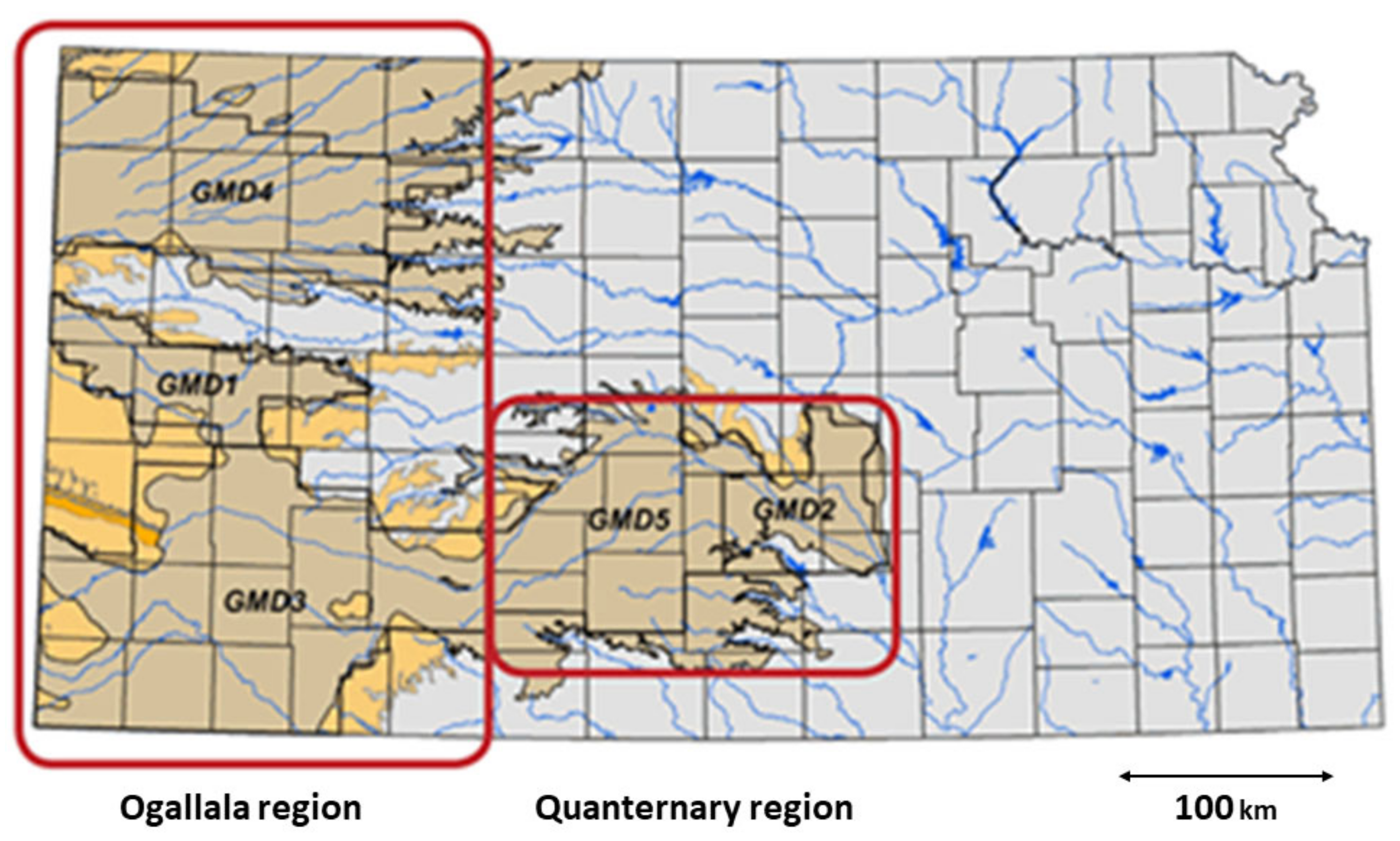
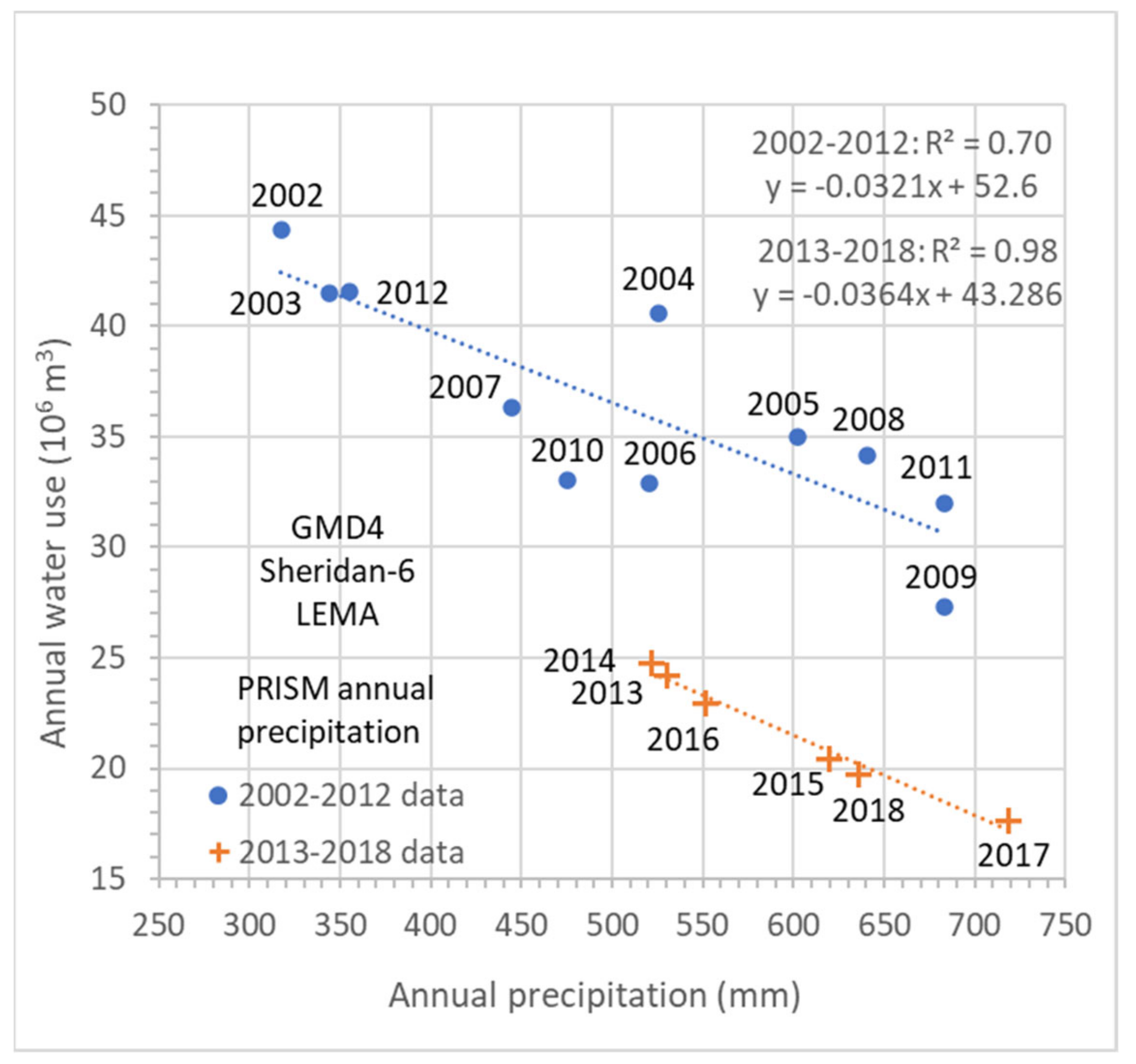


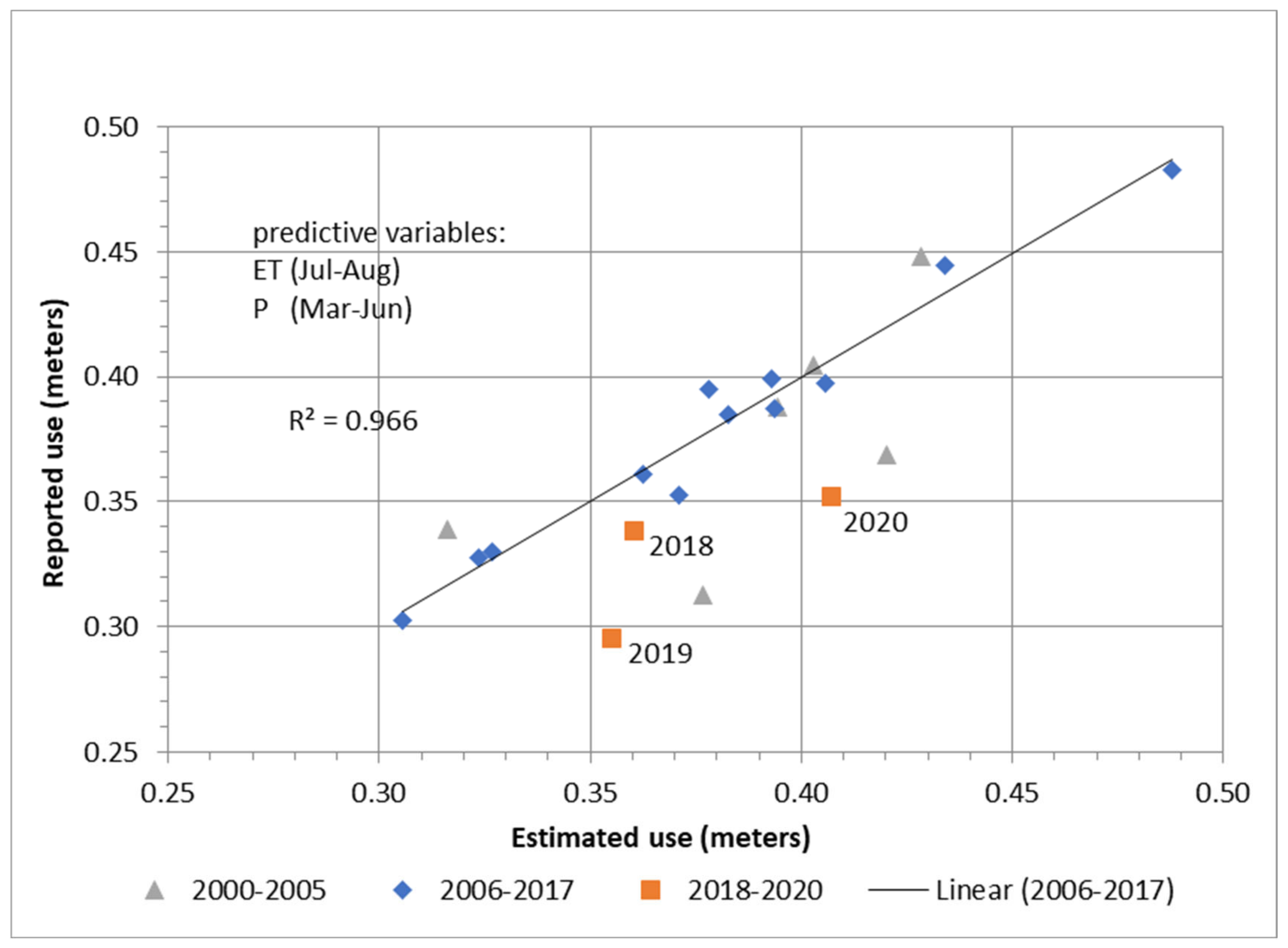
| Year | Law | Policy Implemented under the Law |
|---|---|---|
| 1945 | K.S.A. 82a702. Water Appropriation Act | Established Chief Engineer position in the Division of Water Resources, Department of Agriculture |
| 1972 | K.S.A. 82a-1020 through 82a-1040 Groundwater Management District Act | Five groundwater management districts (GMD) established. GMD’s 1, 3, 4 are over the Ogallala Aquifer |
| 1978 | K.A.R. 5-20-2 | Intensive Groundwater Use Control Areas (IGUCA) authorized |
| 1981 | Kansas Statute 74-2608 | Kansas Water Office established |
| 1981 | Kansas Statute 74-2622 | Kansas Water Authority established |
| 1984 | K.S.A. 82a-703 a, b, c | Minimum streamflows established |
| 2006 | Water Transition Assistance Program pilot established for permanent retirement of partial or full water right in targeted areas. Expires 2022. | |
| 2012 | K.S.A. 82a-1041 | Local Enhanced Management Areas implemented |
| 2015 | K.S.A. 82a-745 | Water Conservation Areas implemented |
| State | Water Law | Permitting Agency | Local Districts | Policy Options | Other |
|---|---|---|---|---|---|
| Texas | Common-law rule of capture | No statewide permitting authority | Groundwater Conservation Areas (WCA) | WCA required to develop plans for desired future conditions (DFC). Can limit allowable annual use. | 50/50 rule is common for DFC, 50% current aquifer storage remains after 50 years |
| New Mexico | Water belongs to the public. Prior appropriation subject to beneficial use. Water rights are private property. | State Engineer Office | No | Adjudication of water rights in NM has not occurred in NE New Mexico Region. | |
| Oklahoma | Surface—prior appropriation. Groundwater—property right with appropriation based on land area and availability of unappropriated water. | Oklahoma Department of Water Resources | No | Annual groundwater use reports required. | Permit required for feedlots, irrigation exceeding 3 ac, commercial use exceeding 5 ac-ft. 26 tribes have water rights dating to time of establishment of a reservation |
| Kansas | Prior appropriation | Chief Engineer, KDA | 5 Groundwater Management Districts, 3 in Ogallala area, with taxing and regulatory authority | Metering, moratorium on new wells. See Table 1 for history of water law and policy. | GMD policy may require approval of Chief Engineer |
| Colorado | Prior appropriation | Colorado Ground Water Commission | 8, 2 in Ogallala | Monitoring, well spacing, new well development | Republican R Compact settlement |
| Nebraska | Correlative rights with reasonable use clause | Nebraska Department of Natural Resources | 23 Natural Resource Districts with taxing authority | Well registration required, Integrated management plans for linked surface and groundwater | Limited state oversite of NRDs. Policy depends on district, may include flowmeters, multi-year allocations, no net new irrigated area |
| Wyoming | Prior appropriation. Water is property of the state. Beneficial use. | Wyoming State Engineer Office | 3 Control Areas in SE Wyoming with local Advisory Boards that advise State Engineer and Board of Control. | Board of Control consisting of State Engineer and four District Supervisors responsible for adjudication of water rights. | Permit required well drilling for beneficial use. Irrigation allocation 1cfs per 70 ac. |
| Reporting Unit | 1989 | 2017 | Change | % Change |
|---|---|---|---|---|
| ha | ha | in ha | Since 1989 | |
| GMD 1 | 118,000 | 71,846 | −46,154 | −39.1 |
| GMD 3 | 636,379 | 563,788 | −72,591 | −11.4 |
| GMD 4 | 145,294 | 158,644 | 13,350 | 9.2 |
| Rest of Western Kansas | 43,269 | 45,740 | 2472 | 5.7 |
| Total of Western Kansas | 942,941 | 840,017 | −102,924 | −10.9 |
| GMD 2 | 38,318 | 61,023 | 22,705 | 59.3 |
| GMD 5 | 173,670 | 185,401 | 11,731 | 6.8 |
| Rest of Central Kansas | 77,971 | 110,545 | 32,573 | 41.8 |
| Total of Central Kansas | 289,959 | 356,968 | 67,009 | 23.1 |
| Total of Eastern Kansas | 21,196 | 40,797 | 19,601 | 92.5 |
| Total of State of Kansas | 1,254,097 | 1,237,783 | −16,313 | −1.3 |
Publisher’s Note: MDPI stays neutral with regard to jurisdictional claims in published maps and institutional affiliations. |
© 2021 by the authors. Licensee MDPI, Basel, Switzerland. This article is an open access article distributed under the terms and conditions of the Creative Commons Attribution (CC BY) license (https://creativecommons.org/licenses/by/4.0/).
Share and Cite
Steiner, J.L.; Devlin, D.L.; Perkins, S.; Aguilar, J.P.; Golden, B.; Santos, E.A.; Unruh, M. Policy, Technology, and Management Options for Water Conservation in the Ogallala Aquifer in Kansas, USA. Water 2021, 13, 3406. https://doi.org/10.3390/w13233406
Steiner JL, Devlin DL, Perkins S, Aguilar JP, Golden B, Santos EA, Unruh M. Policy, Technology, and Management Options for Water Conservation in the Ogallala Aquifer in Kansas, USA. Water. 2021; 13(23):3406. https://doi.org/10.3390/w13233406
Chicago/Turabian StyleSteiner, Jean L., Daniel L. Devlin, Sam Perkins, Jonathan P. Aguilar, Bill Golden, Eduardo A. Santos, and Matt Unruh. 2021. "Policy, Technology, and Management Options for Water Conservation in the Ogallala Aquifer in Kansas, USA" Water 13, no. 23: 3406. https://doi.org/10.3390/w13233406
APA StyleSteiner, J. L., Devlin, D. L., Perkins, S., Aguilar, J. P., Golden, B., Santos, E. A., & Unruh, M. (2021). Policy, Technology, and Management Options for Water Conservation in the Ogallala Aquifer in Kansas, USA. Water, 13(23), 3406. https://doi.org/10.3390/w13233406








